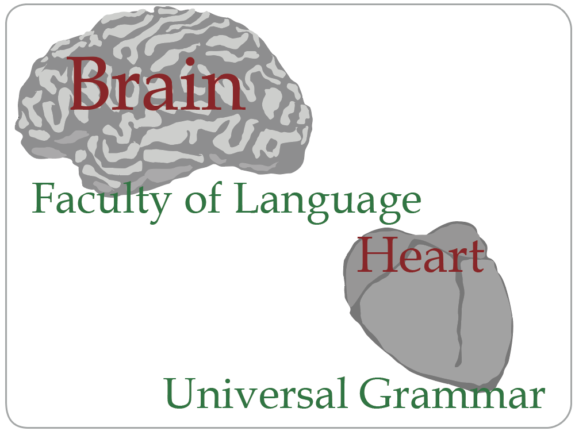
The Faculty of Language and Universal Grammar
Both of the ideas here are contentious and hard to define. One is highly disputed. This website is predicated on the assumption that both are real. But the balance between them is subtle. The interpretations of these ideas here are personal. Mine. My understanding of both is broad compared to some other understandings.
In one sense, the faculty of language is obvious. Human beings can talk. In every human language, there are ways of saying unambiguously:
- I like her.
- Does he like her?
- She doesn’t like him.
- Who does she like?
- Talk to me!
- I think she likes me.
- You see I think she likes me.
As a wise man in my bank once said to me after I told him what I did: There would be no human society without this faculty. It has value.
In every human society the overwhelming majority of the population progress naturally and without any special help to a clear, reliable, exact understanding of all the contrasts here. Without this understanding there would no sense in the notion of either law or comedy. We can use exactly the same words in the same tone of voice, but meaning something seemingly opposite, or at least quite different, in irony or absurd exaggeration, and be understood according to our intended meaning. That understanding depends on a degree of mental synergy. So where there is no synergy, the reversal can be misunderstood. Or perhaps wishing to deny any synergy whatsoever, the listener can deny any understanding, as in the process of making an arrest. In such a scenario, comedy is apt to play badly.
But the richness of the faculty here depends on very precise mechanisms. These, by the framework here, are universal. There are significant variations in the operation of these mechanisms from one language to another, but not in the basic principles involved. Hence the notion of Universal Grammar, commonly known as UG.
There are those, like Michael Tomasello, who dispute that there is any such thing as UG, that the whole of human grammar can be attributed to human culture. But this makes it hard to explain the commonalities across different grammars, most intensely studied by Julie Anne Legate.
UG is like the heart pumping blood with its essential oxygen up to the greedy brain, and allowing the brain to operate.
By the proposal here, the key universality is a function which I call ‘Geometrical Merge’, an extension of Noam Chomsky’s Merge, going back further in human evolution and giving a more complete account of children’s language acquisition.

